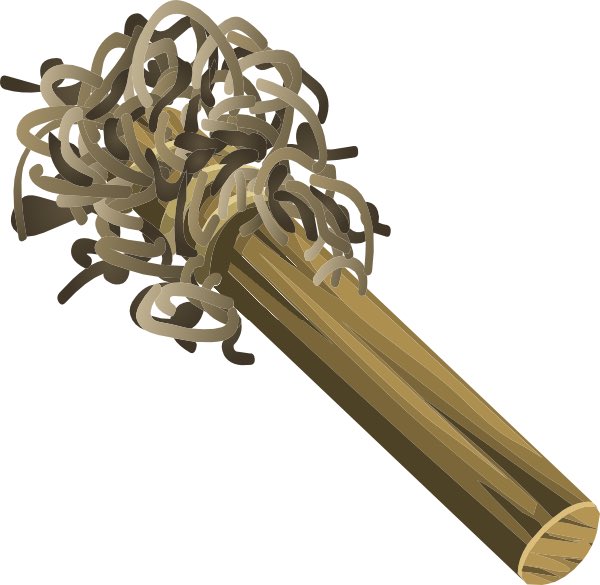Slack is arguably the most crucial tool more than 3 million of us use to get work done on a daily basis—and yet, at the same time, it is the most crippling impediment to that work. One minute, you’re discussing serious, actionable ideas, assigning tasks, setting deadlines; the next, you're spending three hours determining where all the vegetables fit on the spectrum from Lawful Good to Chaotic Evil, or wasting an entire day debating a meme about an animal war.The one constant, whether you and your colleagues are being Responsible and Productive or Deeply Unhinged, is emoji. You react with a :thumbsup: to let your boss know you've heard them; you throw a :tomato: at someone who just made five 69 jokes in a row. Among all these emoji, hiding in the rows of people and activities and objects, is one particular, Slack-specific symbol that towers above all the rest, the single greatest emoji of them all: the dusty stick. Its origins are obscure, its purpose is unclear, and its meaning is hotly, viciously contested. We here at VICE have been using it for years, but—unbeknownst to us until very recently—we don't all have the same conception of what it means. We have been debating its significance for weeks, and this battle is threatening to tear our office apart.Some claim that it is positive: a tool of affirmation, used to confer agreement with an idea or a statement. (You: "We should blog about the sex house." Colleague: "dustystick.") Others, like this reporter, contend that it is negative: a way of saying "woof" to an intentionally dumb, trolly joke or a bad take, akin to the tomato. Something that says "I'm wagging my finger at you, but lightheartedly and with affection." (You, pitching a fake headline: "We Ranked All the Dicks in That 30-Dick Episode of Euphoria." Everyone: "dustystick.") In the words of Peter Slattery, a senior social editor at VICE, "I sort of imagine it like waving a wooden spoon at someone: 'Oh you!'"It has been weeks, and still we cannot come to an agreement on the correct meaning of the dusty stick. The debate raging among us has driven a wedge between one half of the office and the other; it is threatening to ruin friendships; it may very well, as I scream about it in Slack to my bosses in ALL CAPS, cost me my job. To put an end to the Great Dusty Stick Debate of 2019 once and for all, I reached out to a few folks in media to find out what it means to them, and how their teams use it.What I found, during the course of this investigation, was nothing short of disturbing.Bafflingly, shockingly—nay, appallingly—it seems as if virtually no one else even… knows the dusty stick is a thing?!?? Here's Hamilton Nolan, senior writer at Splinter:"I don't know anything about that stick but I asked in Slack and one person said 'what the fuck is that' and another person said 'what.' Hope that is helpful…."Here's Madeleine Aggeler, staff writer at the Cut:"I have never seen this before in my entire life. It means nothing to me."Hunter Harris, staff writer at Vulture:"I've never seen it before! It looks like something from one of the Pirates of the Caribbean movies, specifically Pirates of the Caribbean: Dead Man's Chest. No one at my office uses it."Julia Reinstein, a reporter at BuzzFeed News, said she "actually did not know about the dusty stick emoji though!" Ashley Feinberg, an Extremely Online reporter at Slate, said she had never heard of it. Gaby del Valle, a colleague of mine who formerly worked at Vox and the Outline, said she never encountered it during her time at either publication. It has garnered a paltry number of mentions on Twitter and the wider web.The only person I managed to track down who had heard of the dusty stick, and uses it with some regularity, is Taylor Lorenz, a staff writer at the Atlantic who covers internet culture. Here came another curveball: She said she deploys it to "ward off evil.""Like if someone comes into Slack with a story about a bad date or person being a dick to them, I drop a dusty stick because it banishes the bad energy," she said. "The dusty stick looks like something you’d find in a witch's home. So I think I associate it with magical powers."There is a technically correct answer as to what the dusty stick signifies, supplied by Slack itself, but this answer does not translate to how the stick is actually used. It is obscure and, on the whole, infuriating. The dusty stick was borne out of Glitch, a browser-based game Slack built when it was still known as Tiny Speck. The stick was an item you could use in this game. Namely:It is not, as some have argued, a way to convey agreement. Why would it be? It’s a dusty stick! A stick covered in dust! How could that ever be a good thing! As Lorenz eloquently put it, "Anyone who thinks it's positive or a way to say you agree with something is deluding themselves." Furthermore, we already have dozens of emoji that signify the same thing: check marks, plus-ones, a variety of hearts in several different colors, thumbs-ups, point-ups, claps—you get the point. This base is already covered.No; the dusty stick is not positive. But it's not entirely negative, either. It is a loving, affectionate way to tell someone that you have registered the intentionally idiotic joke they have just made, and you shake your fist at it. You do this out of secondhand shame, but also out of jovial bemusement. It is not the same as the tomato—which is a less-ironic way of telling someone they are being a troll—because there is an element of support attached to it. The dusty stick says to your colleague: "I see what you have done here, you goofball. I acknowledge that it is funny, but it is over-the-top, and it cannot be fully condoned or encouraged. I wag my finger at you, like a grandmother at a mischievous child, and I clear the way for conversation to continue."The dusty stick is, apparently, the least-used emoji in Slack's canon; and yet it is the best emoji in that canon. Its convoluted, cryptic history, its tendency to polarize, and—when used correctly—its highly specific ability to signal disdain, support, amusement, and "woof," all at the same time, can be found nowhere else in the emoji lexicon. It is a thing of true, unparalleled beauty.Here's to hoping that—at the end of an arduous, thorough investigation, and yet another workday wasted almost entirely on Slack—the dusty stick finally starts getting the kind of use it deserves.Sign up for our newsletter to get the best of VICE delivered to your inbox daily.Follow Drew Schwartz on Twitter.
Its origins are obscure, its purpose is unclear, and its meaning is hotly, viciously contested. We here at VICE have been using it for years, but—unbeknownst to us until very recently—we don't all have the same conception of what it means. We have been debating its significance for weeks, and this battle is threatening to tear our office apart.Some claim that it is positive: a tool of affirmation, used to confer agreement with an idea or a statement. (You: "We should blog about the sex house." Colleague: "dustystick.") Others, like this reporter, contend that it is negative: a way of saying "woof" to an intentionally dumb, trolly joke or a bad take, akin to the tomato. Something that says "I'm wagging my finger at you, but lightheartedly and with affection." (You, pitching a fake headline: "We Ranked All the Dicks in That 30-Dick Episode of Euphoria." Everyone: "dustystick.") In the words of Peter Slattery, a senior social editor at VICE, "I sort of imagine it like waving a wooden spoon at someone: 'Oh you!'"It has been weeks, and still we cannot come to an agreement on the correct meaning of the dusty stick. The debate raging among us has driven a wedge between one half of the office and the other; it is threatening to ruin friendships; it may very well, as I scream about it in Slack to my bosses in ALL CAPS, cost me my job. To put an end to the Great Dusty Stick Debate of 2019 once and for all, I reached out to a few folks in media to find out what it means to them, and how their teams use it.What I found, during the course of this investigation, was nothing short of disturbing.Bafflingly, shockingly—nay, appallingly—it seems as if virtually no one else even… knows the dusty stick is a thing?!?? Here's Hamilton Nolan, senior writer at Splinter:"I don't know anything about that stick but I asked in Slack and one person said 'what the fuck is that' and another person said 'what.' Hope that is helpful…."Here's Madeleine Aggeler, staff writer at the Cut:"I have never seen this before in my entire life. It means nothing to me."Hunter Harris, staff writer at Vulture:"I've never seen it before! It looks like something from one of the Pirates of the Caribbean movies, specifically Pirates of the Caribbean: Dead Man's Chest. No one at my office uses it."Julia Reinstein, a reporter at BuzzFeed News, said she "actually did not know about the dusty stick emoji though!" Ashley Feinberg, an Extremely Online reporter at Slate, said she had never heard of it. Gaby del Valle, a colleague of mine who formerly worked at Vox and the Outline, said she never encountered it during her time at either publication. It has garnered a paltry number of mentions on Twitter and the wider web.The only person I managed to track down who had heard of the dusty stick, and uses it with some regularity, is Taylor Lorenz, a staff writer at the Atlantic who covers internet culture. Here came another curveball: She said she deploys it to "ward off evil.""Like if someone comes into Slack with a story about a bad date or person being a dick to them, I drop a dusty stick because it banishes the bad energy," she said. "The dusty stick looks like something you’d find in a witch's home. So I think I associate it with magical powers."There is a technically correct answer as to what the dusty stick signifies, supplied by Slack itself, but this answer does not translate to how the stick is actually used. It is obscure and, on the whole, infuriating. The dusty stick was borne out of Glitch, a browser-based game Slack built when it was still known as Tiny Speck. The stick was an item you could use in this game. Namely:It is not, as some have argued, a way to convey agreement. Why would it be? It’s a dusty stick! A stick covered in dust! How could that ever be a good thing! As Lorenz eloquently put it, "Anyone who thinks it's positive or a way to say you agree with something is deluding themselves." Furthermore, we already have dozens of emoji that signify the same thing: check marks, plus-ones, a variety of hearts in several different colors, thumbs-ups, point-ups, claps—you get the point. This base is already covered.No; the dusty stick is not positive. But it's not entirely negative, either. It is a loving, affectionate way to tell someone that you have registered the intentionally idiotic joke they have just made, and you shake your fist at it. You do this out of secondhand shame, but also out of jovial bemusement. It is not the same as the tomato—which is a less-ironic way of telling someone they are being a troll—because there is an element of support attached to it. The dusty stick says to your colleague: "I see what you have done here, you goofball. I acknowledge that it is funny, but it is over-the-top, and it cannot be fully condoned or encouraged. I wag my finger at you, like a grandmother at a mischievous child, and I clear the way for conversation to continue."The dusty stick is, apparently, the least-used emoji in Slack's canon; and yet it is the best emoji in that canon. Its convoluted, cryptic history, its tendency to polarize, and—when used correctly—its highly specific ability to signal disdain, support, amusement, and "woof," all at the same time, can be found nowhere else in the emoji lexicon. It is a thing of true, unparalleled beauty.Here's to hoping that—at the end of an arduous, thorough investigation, and yet another workday wasted almost entirely on Slack—the dusty stick finally starts getting the kind of use it deserves.Sign up for our newsletter to get the best of VICE delivered to your inbox daily.Follow Drew Schwartz on Twitter.
Advertisement

Advertisement
Advertisement
What the hell is that? What does it even mean? No one really knows, and it doesn't really matter. The origin of the dusty stick is not the same as the meaning of the dusty stick, and it is the meaning that matters.So now—left with no other option—I have taken it upon myself to lay out, comprehensively and definitively, for the first and last time, the true purpose of the dusty stick.A special gift to commemorate the Great Item Loss of early 2012. Build up the power of your stick throughout the day. When ready, release it in order to spread happiness to all those around you.
Advertisement

